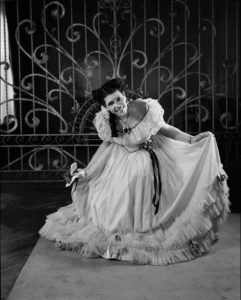Camille Nickerson
Born in New Orleans on March 30, 1888, composer Camille Nickerson was a highly accomplished musician and scholar.

Courtesy of Smithsonian Archives of American Art
Camille Nickerson Bowing. Scurlock Studio Records
Composer Camille Nickerson was a highly accomplished musician and academic especially noted for collecting and arranging Creole folksongs. Billed as “The Louisiana Lady,” Nickerson performed and lectured about Creole music while costumed in nineteenth-century Creole style. She toured in the United States and Europe from 1941 to 1960, and the US State Department sponsored her 1954 tour of France.
Nickerson was born on March 30, 1888, in New Orleans. In her preteen years she joined the Nickerson Ladies’ Orchestra (the first women’s orchestra in New Orleans, directed by her father), as its pianist. In addition to leading the orchestra, William Joseph Nickerson taught music at Southern University in New Orleans, which at the time offered elementary grades through high school as well as some college coursework. Some of Mr. Nickerson’s classically trained students figured prominently in the early days of jazz: Jelly Roll Morton, Emma Barrett, Manuel Manetta, and Henry Kimball. Manetta later recalled Camille as the “greatest pianist they had around here.”
Nickerson received her training at Oberlin Conservatory, the Juilliard School, and Columbia Teachers College. After graduating from Oberlin in 1916, she taught at her father’s Nickerson School of Music and began performing concerts in Southern cities. In 1917 she established the B-Sharp Music Club to promote “Negro Music,” and the group started the New Orleans branch of the National Association of Negro Musicians (NANM) in 1921. Performing free, monthly concerts of classical music, spirituals, and Creole of color songs, the B-Sharp Music Club also raised funds for the NAACP, the Anti-Lynching Fund, and NANM scholarships.
Nickerson enjoyed a long and distinguished career as professor of music at Howard University in Washington, DC, from 1926 to 1962 and as professor emerita from 1962 to 1982. She served several years as president of the National Association of Negro Musicians and organized the Musicians Guild of Washington, DC.
In 1930, Nickerson received a Rosenwald Fellowship and took a leave from Howard University to conduct folkloric research, collecting and preserving Creole songs. In 1932, she received her master’s degree in music from Oberlin for her work, “Afro-Creole Music in Louisiana: A Thesis on the Plantation Songs Created by the Creole Negroes of Louisiana.” In 1942, the Boston Music Company published some of her musical scores as Five Creole Songs Harmonized and Arranged by Camille Nickerson.
Nickerson’s arrangements of these Creole songs are fine examples of folk music transcription. Three of the arrangements, “Michieu Banjo,” “Chère, Mo Lemmé Toi,” and “Dansé Conni Conné” are written in a Caribbean rhythmic idiom. The piano accompaniments are not based on stock patterns but are through-composed and display adept creativity and effective changes in texture. The more lyrical pieces, “Lizette, Ma Chêre Amie” and “Fais Do Do,” betray the acute tonal sensibilities of a fine pianist-composer. In all these arrangements the vocal line remains faithful to the original songs while the piano accompaniment provides a strong sense of narrative and explores the deeper meaning of the texts.
Nickerson died on April 27, 1982, in Washington, D.C. After her death, her papers were given to Howard University. Her impact on the musical community can be seen in the numerous archival repositories that contain information about her career, including, but not limited to, the Marian Anderson Papers (University of Pennsylvania), Louise Burge Papers (Howard University), Eva Jessye Collection (Pittsburgh State University), Ray M. Lawless Collection (Library of Congress), and the National Negro Opera Company Collection (Library of Congress). The Amistad Research Center at Tulane University holds a large collection of materials on the B-Sharp Music Club as well as a copy of Nickerson’s master’s thesis and her sheet music, Five Creole Songs. Tulane’s Hogan Archive also has a vertical file on the B-Sharp Music Club.
